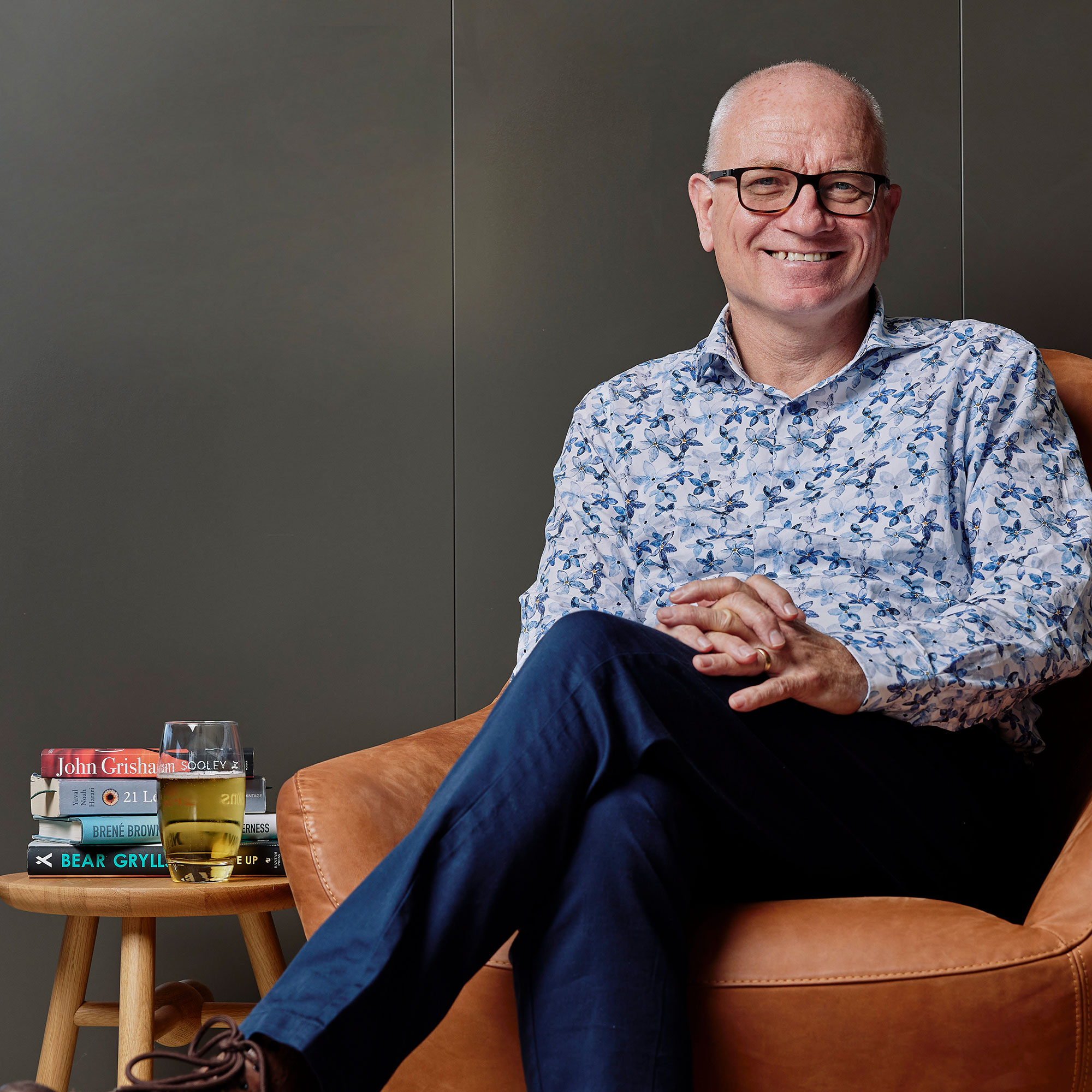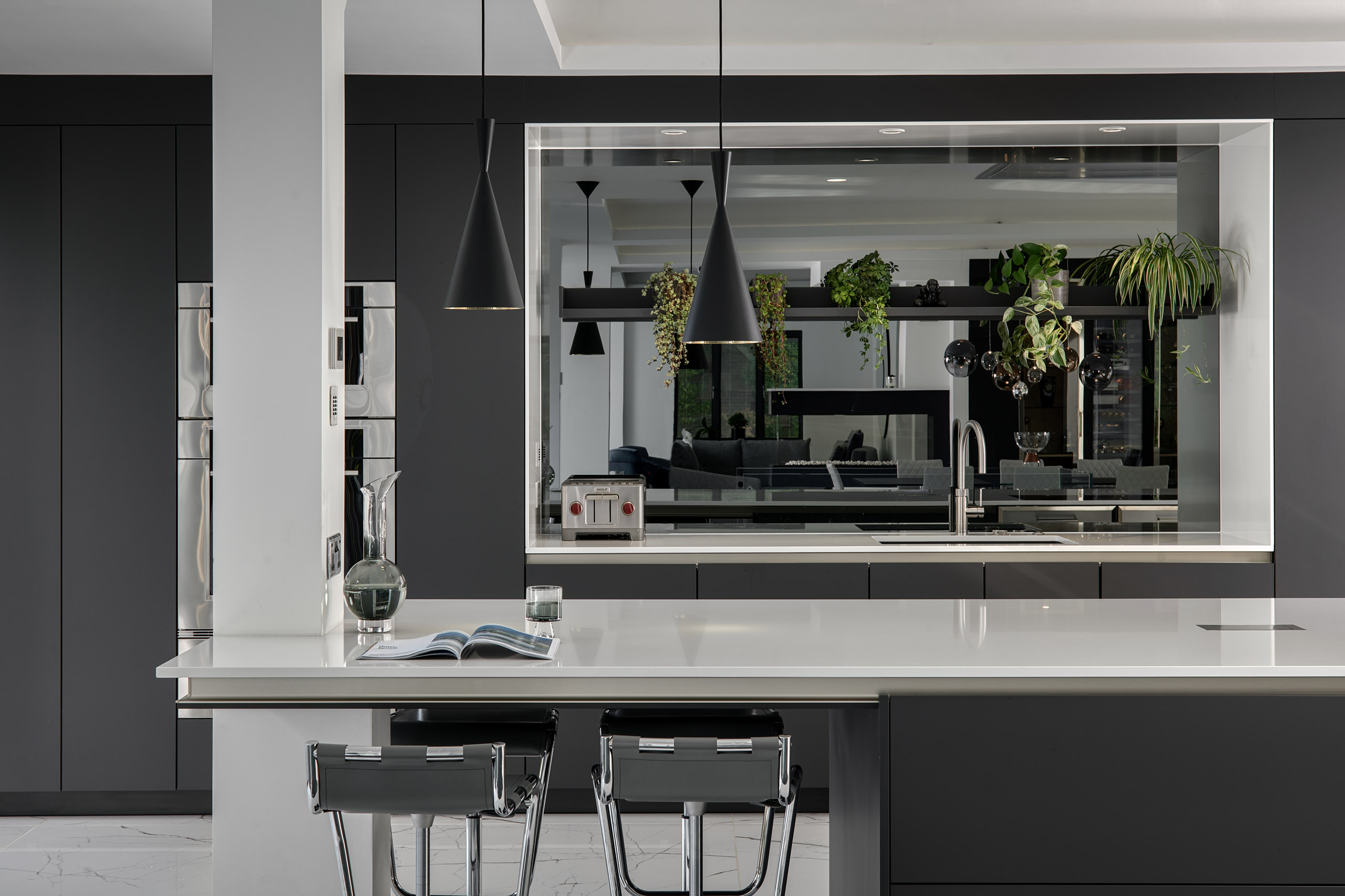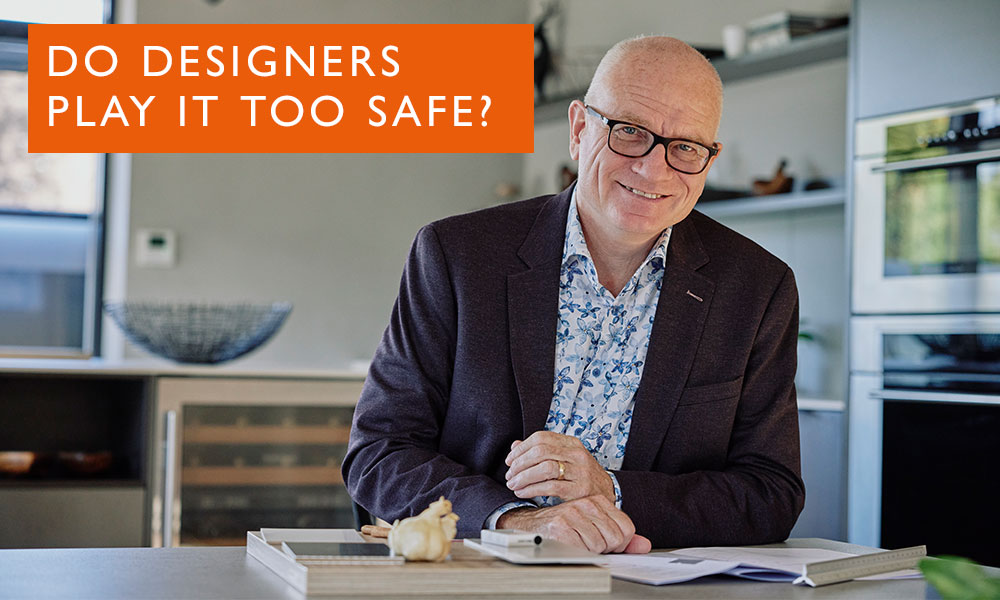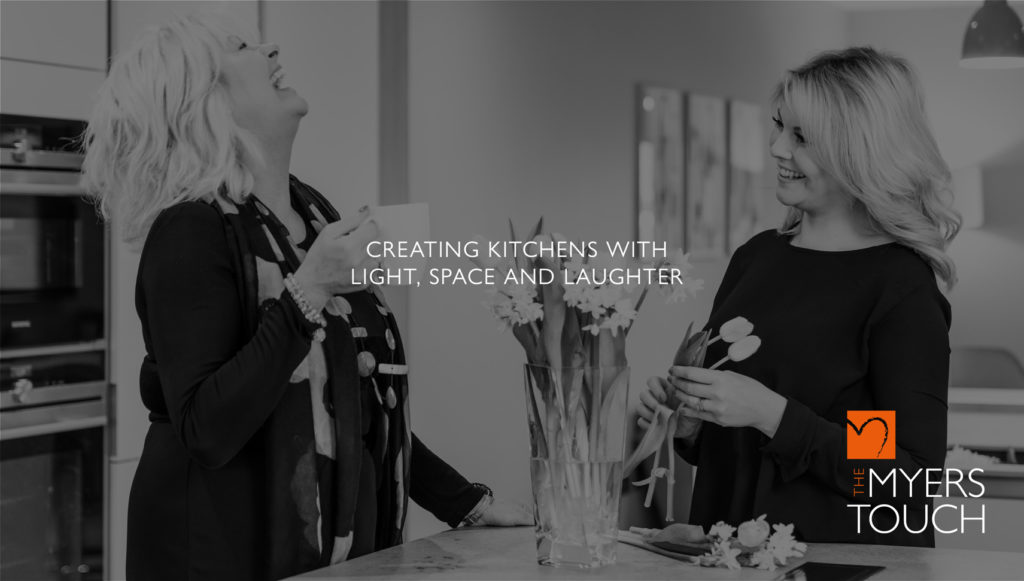Do Designers Play It Safe?

In this thought-provoking Design Talk, Keith Myers of The Myers Touch explores a question facing the world of interior design, do designers play it too safe? Join us as we explore the delicate balance between conventional ideas and bold innovation in kitchen design.

Conventional and bold kitchen design : A Virtual Design Talk
Inspiring talks and practical advice

Good evening and welcome to The Myers Touch and our design talk series. It’s lovely to have you here with us today. I’m just getting myself set up and organised. If it’s your first time with us, you’re absolutely welcome to join us tonight. Tonight’s talk will be roughly about 35 to 40 minutes, possibly a bit less if I talk fast or don’t spend as much time on each slide as planned.
For those of you new to us, we’ve been running this series for the last couple of years. Since lockdown, we’ve moved our talks online and currently hold them every two weeks. This may change, so keep an eye on the emails we send out for updates on our projects and upcoming design talks.
Tonight’s talk is titled “Do Designers Play It Safe?”
It’s a subject I find really interesting, and I hope you will too as we go through the presentation. I’ll briefly touch on who The Myers Touch are for about a minute, then move on to some more technical information before showcasing some projects we’ve been working on. This background information is necessary to put the projects into context.
The Myers Touch has been around since about 2003 when we started the business as interior designers and interior architects. We did design and build, and this is our studio in Winchester, just outside Winchester. It’s very accessible from the motorway with easy parking, which is quite unusual. On the right-hand side, you can see a few of the design awards we’ve been delighted to win over the years. This picture here is the inside of our studio. We won Kitchen Showroom of the Year a couple of years ago, which was a tough competition to participate in and win. We’ve been the only kitchen company in England for the last three years to be up for Kitchen Retailer of the Year and Kitchen Showroom of the Year, which we’re obviously delighted about.
So, do designers play it safe? That’s a really interesting question. The first question to ask is, who is a designer? The first thing that may surprise you is that everyone is a designer. Over the years, we’ve seen the development of numerous TV programmes like Grand Designs, George Clarke’s Small Spaces, and 60 Minute Makeover. These programmes, some inspirational and some a bit cheesy, have significantly promoted the home sector. The followings and ratings of these programmes make it worthwhile for TV companies to invest in them. They train, equip, and empower everyone to move into design in some form.
The DIY market has grown significantly over the years
I read an article recently that said the global spend on the DIY sector was around 32 billion US dollars in 2013, and in 2019 it was 144 billion, a significant increase. DIY shops now offer fantastic design ideas that can help and empower you to make good choices. The magazine market has also grown, with a significant chunk of home-type magazines available, offering amazing help to empower people to learn how to design. The internet has changed all our lives, especially since lockdown. Online design tools now allow you to design your own kitchen, move the boxes around, place them where you want them, test it out, and measure it, all from the comfort of your own home. There’s also plenty of online help available.
I want to break this down into the types of designers we’re dealing with.
There’s no right or wrong here; it’s just how I see it. The first type of designer is what I call a copy designer. This is a great place if you’re inexperienced or don’t have the time or money to invest. You can go to websites like Dulux, which suggest wall colours and wallpaper colours, and you can buy pre-made room design configurations. Laura Ashley used to offer a suite of wallpapers, furniture, materials, and carpets that could be pulled together with a pre-made design. It’s a fantastic way to quickly and confidently achieve the design you want.
The next type of designer is the hobbyist or amateur designer. These are people who enjoy interiors, colours, and design, and do their own spaces in their homes and sometimes for friends. In another life, they might be interior designers, or maybe it’s too late in life, or they’re better at something else that probably pays better. These people have lots of time because it’s a hobby for them. They get energised by doing it, can research, go on Pinterest, search the internet, collect magazines, build their ideas, and do it very well.
Another type of designer is the builder designer, or tradesperson. I’ve met many builders and carpenters over the years who design things on-site for clients. Because they’re experienced and have been in the game for a long time, they’ve seen lots of things and can do a fantastic job at a basic level of design.
Those of you who’ve been on my talks before will know my thoughts on kitchen planners versus kitchen designers. A kitchen planner helps facilitate your ideas into a plan and design. A significant part of the kitchen and bathroom design market fits into this category quite nicely and successfully.
The last type is the professional designer. These are people who have gone to university, spent many years training, and have been in the industry for some time. This includes architects, interior designers, and interior architects, which is a blend of interior design and architecture. At The Myers Touch, we have two interior architects, a spatial designer, and an interior designer, all qualified to support our clients.
Safe Design
It’s an interesting term that came from an article I wrote as a blog, which then went on LinkedIn and led to an interview for the kitchen and bathroom sector. Safe design often means following the architecture or design of the building. For example, if you have a farmhouse, you put in a farmhouse kitchen. If you have a listed building, you put in a listed, authentic character type, working with the ceilings or beams to create a classic kitchen in a classic building. Traditional in traditional and contemporary in contemporary. You can’t really go wrong by following the architecture, but you can go wrong in design by putting the wrong type of thing in. If you’re sensible and clear, you can come up with some really nice things that work well.
Copying is like a hairstyle. My wife often shows me a picture of a hairstyle she likes but worries it won’t look right on her. This is a challenge with safe design. You can see something that looks good in its context, but when you try to place it in your space, it doesn’t look right. I’ve seen this with a fireplace in a project some years ago. It looked stunning in its original setting, but when placed in the house, it didn’t feel right and was a costly mistake.
Sometimes, safe design can be too simple. You can oversimplify design, but really good design is not simple. If you try to make it too safe, you end up with something too simple. Following guidelines without understanding the essence or core behind them is another aspect of safe design. Guidelines are fantastic, but they need to be tested and sometimes broken. For example, the kitchen triangle between the hob, fridge, and sink is a well-known guideline, but it’s what I call safe design. Testing or breaking these guidelines can lead to better results.
Safe design can also mean having predefined ideas that you’re unwilling to move on or adapt. This can push you into a place of safety and constraints, and you don’t end up with what you hoped for. The desire to create something that moves you when you walk in is not safe design; it’s much more than that.
Not considering the interior’s architecture is another aspect. If your architecture is wrong, your kitchen or living space may not work out as you hoped. Testing the architecture and making sure it’s right is fundamental to a successful project. Over the years, I’ve changed the architecture of many projects, even structural engineering aspects. Testing the architecture can be crucial to avoiding safe design.
The best design comes from collaborating with those around you. At The Myers Touch, we collaborate as a design team on challenging projects. We brainstorm ideas, and nothing is off the table. This has created some amazing outcomes for our clients. Collaborating with other designers, architects, and the clients themselves always leads to the best design.
“Wow Kitchens”
Here’s an example of a kitchen that was portrayed as a “wow” kitchen. They followed some basic guidelines, like placing the sink in front of the window and creating a kitchen triangle with the hob and fridge. However, there are things I don’t like about this kitchen. The extractor is low-cost and would look nicer built into the furniture. There are too many cabinets, overpowering the room with dark colours. The lighting isn’t right, and the plugs on the wall aren’t centred in the units. The filler reaches the top, not allowing the handleless profile to come through. They’ve followed guidelines and rules but ended up with something functional and dead, not a “wow” kitchen.
To avoid safe design, test the architecture around you. I’ve got some examples in picture form coming up that will illustrate this further. I had a really interesting project.
We were working on a developer’s personal home with a very narrow space. Creating an island and units off the wall was difficult, so I suggested building a niche into the wall and a small extension on the side of the building to house the tall units. This solution worked perfectly as the wall was built into the bank anyway.
It’s interesting how often clients come in with well-researched ideas, having selected products they like. However, they may have missed something crucial for a better design. In our design meetings, we test all their ideas to ensure there isn’t a better option or to understand their choices. We spend every day in this sector and sometimes know better ways to approach things.
Taking risks is essential. I remember a lady who came to us after visiting five kitchen companies, feeling fed up and seeing us as her last hope. A designer needs to take you to a place that feels slightly risky. This doesn’t mean randomly doing something but using risk as a motivator to pull things together.
Introducing ideas that excite and unsettle you is crucial. Often, the first place clients go after getting planning permission is the kitchen company because it’s the most exciting part of the house. We love passion and excitement about what we do, but we also need to move you to a place you couldn’t have gone yourself. Avoiding safe design means not sticking to the comfortable and initial ideas.
Using adventurous materials is also important. We have access to various materials, from sprayed-on metal finishes to wallpaper in kitchens, different glass finishes, stones, and lighting effects. These can help avoid safe design if you know what you’re doing. And, of course, using a qualified designer who understands the market and how things should come together is essential.
Examples of Projects
Surrey Project: We challenged the client’s and architect’s ideas. The kitchen was initially planned where the sofa area is, but we suggested moving it. This couple loves entertaining, and the new layout improved the flow and functionality. The client was thrilled with the transformation.
TV Personality Project: We used adventurous materials like stainless steel, teak, white, and grey laminate. The combination of these materials created a soft feel in the space, despite the kitchen being contemporary and quite harsh.
Hiltonbury Project: We were invited to do a competitive quote for a house being built by a developer. The client asked if we would change anything if involved earlier. We suggested removing a utility room and blocking up a window, which transformed the space. The client appreciated our input, saying we saved them from a major architectural mistake.
Architect Collaboration: We worked with an architect from Fosters in London on a 400-year-old farmhouse with a contemporary extension. The client had designed the kitchen within the existing building, but we suggested breaking the architectural line between the new and old parts. This created a coherent space, and the client was pleased with the result.
Boat Kitchen: A client wanted a boat in his kitchen. This unique project pushed the boundaries of design. It was a one-off, completely unique style and shape, and a delight to work on. We’re now working on their current project.
We were working on a new build house on the Isle of Wight, introducing ideas similar to the boat project with a curved wood shape. We split the worktop with different coloured stones, creating a larger island by connecting the dining table, which saved space. We also added a wine fridge under the stairs and mimicked the island’s shape with a build-down ceiling. This was in a Wimpey home, resulting in one of their most stunning kitchens.
In another project, we were invited to bid for a kitchen redesign. The original kitchen was closed off with a wall, separating it from the rest of the house. We proposed breaking the space to link it together, addressing the split-level challenge. The back units housed the sink, while the hob was on the island, which also featured a radiator. We added a custom table fixed to the end and a TV unit that rises and falls. This design created a cohesive and functional space.
For a Grade II listed arts and crafts mansion outside Romsey, the client wanted a contemporary extension. He desired all ovens and fridges on the back wall and a significant island. We suggested making the extension larger to better fit the interior design. The client later wished he had made the extension bigger. This project highlighted the importance of designing the interior before the exterior.
In another project, we worked with an architect from Fosters in London on a 400-year-old farmhouse with a contemporary extension. The client had designed the kitchen within the existing building, but we suggested breaking the architectural line between the new and old parts. This created a coherent space, and the client was pleased with the result.
One of my favourite projects involved a client who wanted a boat in his kitchen. This unique design pushed the boundaries and resulted in a completely unique style and shape. It was a delight to work on, and we’re now working on their current project.
See more videos of our past talks on our Facebook page. Find out about the latest trends we are seeing in high end kitchen design and book an appointment to visit our kitchen showroom.
